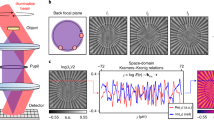Abstract
In this paper, real-time holographic interferometry is applied to determine the absolute-retardation fringes in the photoelastic analysis of plane models. The method requires only one hologram recorded with the model unloaded. In the reconstruction process, the mcdel is loaded and the polarizers on the reference and object beams are rotated through the same angle. At the points of the model where the polarization direction is parallel to one of the principal stresses, only the corresponding family of absolute retardations is obtained. The technique is demonstrated experimentally using a deep beam centrally loaded.
Similar content being viewed by others
Abbreviations
- A′,B′:
-
stress-optic constants
- b:
-
constant
- d′:
-
thickness of the loaded model
- E o1,E o2 :
-
object electric fields on the holographic plate during the hologram recording and reconstruction, respectively
- E r1,E r2 :
-
reference electric fields on the holographic plate during the hologram recording and reconstruction, respectively
- I :
-
light intessity emerging from the hologram
- I r2 :
-
light intensity of the reference beam in the reconstruction process
- x, y :
-
reference coordinate system
- α:
-
angle between the σ 1 direction and the x axis
- δ 1 , δ 2 :
-
absolute retardations in the direction of σ 1 and σ 2 , respectively
- λ:
-
light wavelength in vaccum
- σ 1 , σ 2 :
-
principal stresses
- θ:
-
angle between the transmission axis of the polarizer and the x axis
- +:
-
indicates the complex conjugate of the transpose
- *:
-
indicates the complex conjugate
- Re []:
-
indicates the real part
References
Favre, H., “Sur une nouvelle méthode optique de détermination des tensions interieures,”Revue d'Optique, 8, 193, 241, 289 (1929).
Post, D., “Photoelastic Evaluation of Individual Principal Stresses by Large Field Absolute Retardation Measurements,”Proc. of SESA,13 (2),119–132 (1956).
Post, D., “The Generic Nature of the Absolute Retardation Method of Photoelasticity,”Experimental Mechanics,7 (6),233–241 (1967).
Sciammarella, C. A. andQuintanilla, G., “Techniques for the Determination of Absolute Retardation in Photoelasticity,”Experimental Mechanics,12 (2),57–66 (1972).
Post, D., “Holography and Interferometry in Photoelasticity,”Experimental Mechanics,12 (3),113–123 (1972).
Ajovalasit, A., “A Single Hologram Technique for the Determination of Absolute Retardations in Holographic Photoelasticity,”J. of Strain Analysis,10 (3),148–152 (1975).
Jones, R. C., “ASNew Calculus for the Treatment of Optical Systems,”J. of Opt. Soc. Am.,31 (7),488–503 (1941).
Sanford, R. J., “Differential Stress-Holo-Interferometry,”Experimental Mechanics,13 (8),330–338 (1973).
Cernosek, J. andMcDonald, S., “On the Effect of Quarter-waveplate Errors in Stress-Holo-Interferometry,”Experimental Mechanics,14 (10),403–407 (1974).
Author information
Authors and Affiliations
Rights and permissions
About this article
Cite this article
Ajovalasit, A., Bardi, A. Holographic photoelasticity: Determination of absolute retardations by a single hologram. Experimental Mechanics 16, 273–275 (1976). https://doi.org/10.1007/BF02321153
Issue Date:
DOI: https://doi.org/10.1007/BF02321153




